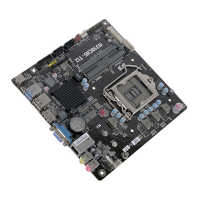
Do you have a question about the ECS H310CH5-TI2 and is the answer not in the manual?
| Form Factor | Micro ATX |
|---|---|
| Chipset | Intel H310 |
| CPU Socket | LGA 1151 |
| Memory Type | DDR4 |
| Memory Slots | 2 |
| Max Memory | 32 GB |
| Storage | 4 x SATA 6Gb/s |
| CPU Support | 8th/9th Gen Intel Core/Pentium/Celeron |
| Expansion Slots | 1 x PCIe x16, 2 x PCIe x1 |
| USB Ports | 2 x USB 2.0 |
| Video Outputs | 1 x HDMI |
| LAN | Realtek RTL8111H Gigabit LAN |
| Audio | Realtek ALC887 |
Details CPU socket type and maximum wattage supported.
Identifies the onboard Intel H310 Chipset.
Specifies dual channel memory architecture and DDR4 support.
Lists M.2 slots for WiFi/BT and SSDs.
Outlines support for SATA storage devices.
Describes the 6-channel HD audio codec.
Details the Gigabit LAN controller and wake-up features.
Lists all external connectors on the motherboard's rear panel.
Details internal headers for fans, USB, and front panel connections.
Lists BIOS features, recovery, display, and boot options.
Specifies the motherboard's physical dimensions as Thin Mini ITX.
LGA1151 socket for Intel® Coffee Lake Processor.
M.2 socket (Key-M) for SSDs (SATA/PCIe Gen.2).
Clear CMOS jumper for resetting BIOS settings.
M.2 socket (Key-E) for WiFi (PCIe Gen.2) / BT.
2 Channels audio speaker header for All-In-One specification.
Digital microphone header for All-In-One specification.
Front panel audio header for audio connections.
Onboard Bluetooth functionality.
Case open header for security monitoring.
DDR4 SO-DIMM sockets for memory modules.
SATA power connector for storage devices.
USB 2.0 header (black) for card reader/camera.
USB 2.0 header (yellow) for touch panel.
Front panel USB 3.0 header for high-speed devices.
Serial ATA 6Gb/s connectors for storage devices.
4-pin system cooling fan connector with smart fan function.
4-pin CPU cooling fan connector with smart fan function.
Onboard serial port header for legacy devices.
Front panel switch/LED header for case controls.
Consumer infrared header for remote control.
LVDS connector for specific display connections.
LVDS brightness switch header for display adjustment.
LVDS brightness control header for display adjustment.
LCD panel select jumper for display configuration.
Trusted platform module header for security.
Pin definition for front panel switches and LEDs.
Pin definition for front panel audio connections.
Pin definition for the onboard serial port header.
Pin definition for USB 2.0 header for card reader/camera.
Pin definition for the speaker header.
Pin definition for system and CPU fan connectors.
Pin definition for chassis intrusion detection.
Pin definition for the consumer infrared header.
Pin definition for the digital microphone header.
Pin definition for the Trusted Platform Module header.
Pin definition for USB 2.0 header for touch panel.
Pin definition for LVDS connectors and controls.
Pin definition for the front panel USB 3.0 header.
Pin definition for the LCD panel select jumper.
Pin definition and usage for the CMOS clear jumper.
Pin definition for LVDS brightness control.
Port for connecting the power adapter.
Ports for connecting USB 3.0 devices.
Ports for connecting USB 2.0 devices.
Port for connecting a display device via HDMI.
Port for connecting a monitor via VGA.
Port for network connection via RJ-45.
Audio output for speakers or headphones.
Audio input for connecting a microphone.
Guide for installing the CPU and its cooling fan.
Instructions for inserting RAM modules into DIMM slots.
Steps for mounting the motherboard into the computer case.
Details on connecting SATA cables and power connectors.
Guide to connecting peripherals to the case ports.
Explanation of BIOS setup utility and default settings.
